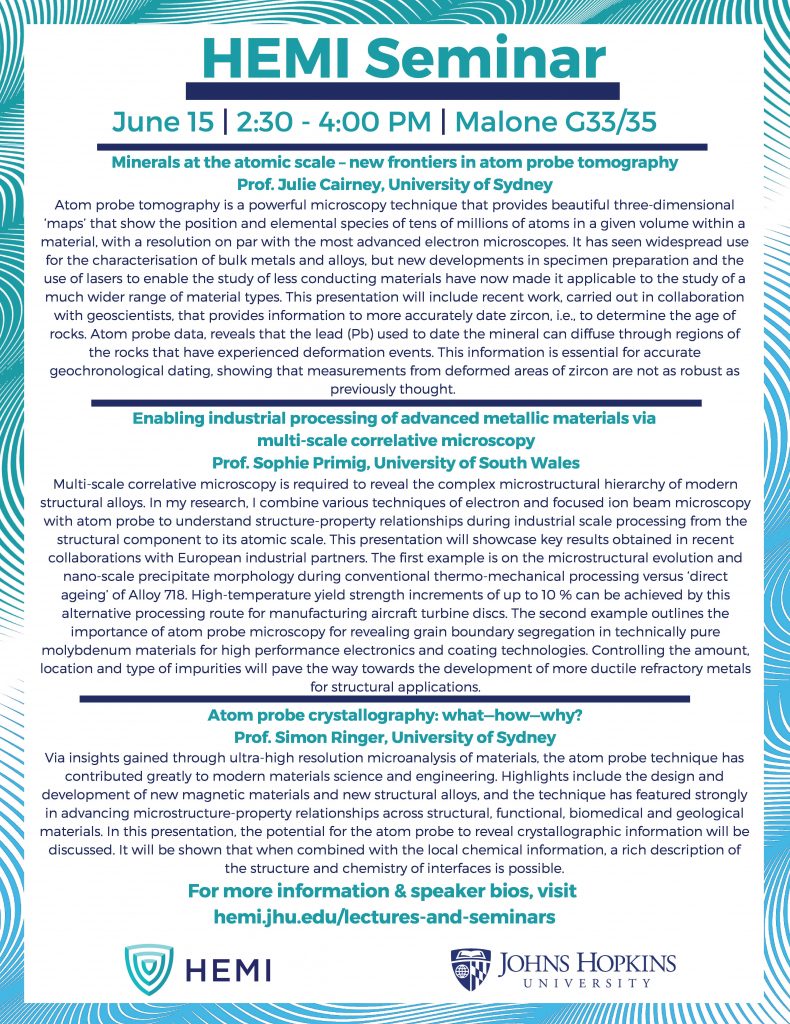June 15, 2018 @ 2:30 pm - 4:00 pm
Event Navigation
Minerals at the atomic scale – new frontiers in atom probe tomography
Professor Julie Cairney, U. of Sydney
Atom probe tomography is a powerful microscopy technique that provides beautiful three-dimensional ‘maps’ that show the position and elemental species of tens of millions of atoms in a given volume within a material, with a resolution on par with the most advanced electron microscopes. It has seen widespread use for the characterisation of bulk metals and alloys, but new developments in specimen preparation and the use of lasers to enable the study of less conducting materials have now made it applicable to the study of a much wider range of material types. This presentation will include recent work, carried out in collaboration with geoscientists, that provides information to more accurately date zircon, i.e., to determine the age of rocks. Atom probe data, reveals that the lead (Pb) used to date the mineral can diffuse through regions of the rocks that have experienced deformation events. This information is essential for accurate geochronological dating, showing that measurements from deformed areas of zircon are not as robust as previously thought.
Bio: Prof. Julie Cairney (USyd) is one of Australia’s leading specialists in using advanced microscopy to study the three-dimensional structure of materials at the atomic scale. She is the Director of the Australian Centre for Microscopy and Microanalysis (ACMM) at the University of Sydney, and CEO of the Australian Microscopy and Microanalysis Research Facility (AMMRF). She is also a passionate contributor to the broader scientific community and was selected as one the World Economic Forum’s 50 Young Scientists of 2016. She has made vital contributions to developing new microscopy technologies, including computational approaches to the analysis of three-dimensional maps of atoms obtained by atom probe microscopy and a new method for crystal orientation mapping by transmission Kikuchi diffraction. These new techniques have been adopted in microscopy labs around the world and allowed her to make an impact across a range of research fields, ranging from metallurgy to functional materials and even geology.
Enabling industrial processing of advanced metallic materials via multi-scale correlative microscopy
Professor Sophie Primig, University New South Wales, Sydney
Multi-scale correlative microscopy is required to reveal the complex microstructural hierarchy of modern structural alloys. In my research, I combine various techniques of electron and focused ion beam microscopy with atom probe to understand structure-property relationships during industrial scale processing from the structural component to its atomic scale. This presentation will showcase key results obtained in recent collaborations with European industrial partners. The first example is on the microstructural evolution and nano-scale precipitate morphology during conventional thermo-mechanical processing versus ‘direct ageing’ of Alloy 718. High-temperature yield strength increments of up to 10 % can be achieved by this alternative processing route for manufacturing aircraft turbine discs. The second example outlines the importance of atom probe microscopy for revealing grain boundary segregation in technically pure molybdenum materials for high performance electronics and coating technologies. Controlling the amount, location and type of impurities will pave the way towards the development of more ductile refractory metals for structural applications.
Bio: Dr Sophie Primig is currently a tenured Senior Lecturer and Australian Research Council DECRA Fellow in the School of Materials Science & Engineering at UNSW Sydney. A physical metallurgist with a track record in both fundamental and industry-focused research, her research goal is to develop an advanced capability in structure-property relationships across the processing route of metallic materials. The focus of her research is on advanced steels, nickel-based alloys, and refractory metals, and this has often been linked closely to the needs of her international industrial partners. Experimentally, she applies characterisation techniques such as atom probe and electron microscopy and has developed new correlative methodologies that enable observations over multiple imaging scales.
Atom probe crystallography: what—how—why?
Professor Simon Ringer, U. of Sydney
Via insights gained through ultra-high resolution microanalysis of materials, the atom probe technique has contributed greatly to modern materials science and engineering. Highlights include the design and development of new magnetic materials and new structural alloys, and the technique has featured strongly in advancing microstructure-property relationships across structural, functional, biomedical and geological materials. In this presentation, the potential for the atom probe to reveal crystallographic information will be discussed. It will be shown that when combined with the local chemical information, a rich description of the structure and chemistry of interfaces is possible.
Simon Ringer is a Professor of materials science and engineering at the University of Sydney. His research is focused on materials design at the atomic-scale and his contributions span a wide range of materials from light alloys, advanced steels, and a range of semiconductors for photovoltaics and nano-electronics. He is interested in solute atom clustering and segregation, and how these relate to phase transformations behaviour and materials properties. He is Academic Director of Core Research Facilities at the University of Sydney, where he is responsible for the University’s research infrastructure strategy, planning and operations.





